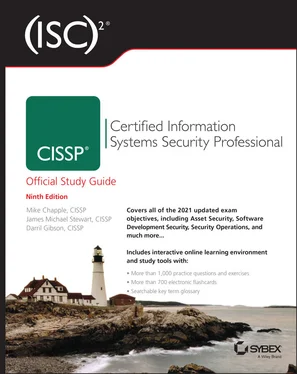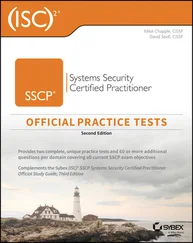This attitude is one of the most common arguments against committing resources to BCP. In many organizations, the attitude that the business has always survived, and the key leaders will figure something out in the event of a disaster, pervades corporate thinking. If you encounter this objection, you might want to point out to management the costs that will be incurred by the business (both direct costs and the indirect cost of lost opportunities) for each day that the business is down. Then ask them to consider how long a disorganized recovery might take when compared to an orderly, planned continuity of operations (COOP).
Conducting a formal BCP effort is particularly important in healthcare organizations, where the unavailability of systems could have life-or-death consequences. In October 2020, the U.S. Cybersecurity and Infrastructure Security Agency (CISA) issued an alert notifying healthcare organizations of an outbreak of ransomware activity specifically targeting their work. Strong continuity plans play an essential role in defending against these availability attacks.
Legal and Regulatory Requirements
Many industries may find themselves bound by federal, state, and local laws or regulations that require them to implement various degrees of BCP. We've already discussed one example in this chapter—the officers and directors of publicly traded firms have a fiduciary responsibility to exercise due diligence in the execution of their business continuity duties. In other circumstances, the requirements (and consequences of failure) might be even more severe. Emergency services, such as police, fire, and emergency medical operations, have a responsibility to the community to continue operations in the event of a disaster. Indeed, their services become even more critical in an emergency that threatens public safety. Failure to implement an effective BCP could result in the loss of life or property and decrease public confidence in the government.
In many countries, financial institutions, such as banks, brokerages, and the firms that process their data, are subject to strict government and international banking and securities regulations. These regulations are necessarily strict because their purpose is to ensure the continued operation of the institution as a crucial part of the economy. When pharmaceutical manufacturers must produce products in less-than-optimal circumstances following a disaster or in response to a rapidly emerging pandemic, they are required to certify the purity of their products to government regulators. There are countless other examples of industries that are necessary to continue operating in the event of an emergency by various laws and regulations.
Even if you're not bound by any of these considerations, you might have contractual obligations to your clients that require you to implement sound BCP practices. If your contracts include commitments to customers expressed as service-level agreements (SLAs), you might find yourself in breach of those contracts if a disaster interrupts your ability to service your clients. Many clients may feel sorry for you and want to continue using your products/services, but their own business requirements might force them to sever the relationship and find new suppliers.
On the flip side of the coin, developing a strong, documented business continuity plan can help your organization win new clients and additional business from existing clients. If you can show your customers the sound procedures you have in place to continue serving them in the event of a disaster, they'll place greater confidence in your firm and might be more likely to choose you as their preferred vendor. That's not a bad position to be in!
All of these concerns point to one conclusion—it's essential to include your organization's legal counsel in the BCP process. They are intimately familiar with the legal, regulatory, and contractual obligations that apply to your organization. They can help your team implement a plan that meets those requirements while ensuring the continued viability of the organization to the benefit of all—employees, shareholders, suppliers, and customers alike.
 Laws regarding computing systems, business practices, and disaster management change frequently. They also vary from jurisdiction to jurisdiction. Be sure to keep your attorneys involved throughout the lifetime of your BCP, including the testing and maintenance phases. If you restrict their involvement to a pre-implementation review of the plan, you may not become aware of the impact that changing laws and regulations have on your corporate responsibilities.
Laws regarding computing systems, business practices, and disaster management change frequently. They also vary from jurisdiction to jurisdiction. Be sure to keep your attorneys involved throughout the lifetime of your BCP, including the testing and maintenance phases. If you restrict their involvement to a pre-implementation review of the plan, you may not become aware of the impact that changing laws and regulations have on your corporate responsibilities.
Once your BCP team completes the four stages of preparing to create a business continuity plan, it's time to dive into the heart of the work—the business impact analysis (BIA). The BIA identifies the business processes and tasks that are critical to an organization's ongoing viability and the threats posed to those resources. It also assesses the likelihood that each threat will occur and the impact those occurrences will have on the business. The results of the BIA provide you with quantitative measures that can help you prioritize the commitment of business continuity resources to the various local, regional, and global risk exposures facing your organization.
It's important to realize that there are two different types of analyses that business planners use when facing a decision:
Quantitative Impact Assessment Involves the use of numbers and formulas to reach a decision. This type of data often expresses options in terms of the dollar value to the business.
Qualitative Impact Assessment Takes non-numerical factors, such as reputation, investor/customer confidence, workforce stability, and other concerns, into account. This type of data often results in categories of prioritization (such as high, medium, and low).
 Quantitative analysis and qualitative assessment both play an essential role in the BCP process. However, most people tend to favor one type of analysis over the other. When selecting the individual members of the BCP team, try to achieve a balance between people who prefer each strategy. This approach helps develop a well-rounded BCP and will benefit the organization in the long run.
Quantitative analysis and qualitative assessment both play an essential role in the BCP process. However, most people tend to favor one type of analysis over the other. When selecting the individual members of the BCP team, try to achieve a balance between people who prefer each strategy. This approach helps develop a well-rounded BCP and will benefit the organization in the long run.
The BIA process described in this chapter approaches the problem from both quantitative and qualitative points of view. However, it's tempting for a BCP team to “go with the numbers” and perform a quantitative assessment while neglecting the somewhat more subjective qualitative assessment. The BCP team should perform a qualitative analysis of the factors affecting your BCP process. For example, if your business is highly dependent on a few important clients, your management team is probably willing to suffer a significant short-term financial loss to retain those clients in the long term. The BCP team must sit down and discuss (preferably with the involvement of senior management) qualitative concerns to develop a comprehensive approach that satisfies all stakeholders.
 As you work your way through the BIA process, you will find that it is quite similar to the risk assessment process covered in Chapter 2, “Personnel Security and Risk Management Concepts.”The techniques used are very similar because both use standard risk evaluation techniques. The major difference is that the risk assessment process is focused on individual assets, whereas the BCP focuses on business processes and tasks.
As you work your way through the BIA process, you will find that it is quite similar to the risk assessment process covered in Chapter 2, “Personnel Security and Risk Management Concepts.”The techniques used are very similar because both use standard risk evaluation techniques. The major difference is that the risk assessment process is focused on individual assets, whereas the BCP focuses on business processes and tasks.
Читать дальше

 Laws regarding computing systems, business practices, and disaster management change frequently. They also vary from jurisdiction to jurisdiction. Be sure to keep your attorneys involved throughout the lifetime of your BCP, including the testing and maintenance phases. If you restrict their involvement to a pre-implementation review of the plan, you may not become aware of the impact that changing laws and regulations have on your corporate responsibilities.
Laws regarding computing systems, business practices, and disaster management change frequently. They also vary from jurisdiction to jurisdiction. Be sure to keep your attorneys involved throughout the lifetime of your BCP, including the testing and maintenance phases. If you restrict their involvement to a pre-implementation review of the plan, you may not become aware of the impact that changing laws and regulations have on your corporate responsibilities. Quantitative analysis and qualitative assessment both play an essential role in the BCP process. However, most people tend to favor one type of analysis over the other. When selecting the individual members of the BCP team, try to achieve a balance between people who prefer each strategy. This approach helps develop a well-rounded BCP and will benefit the organization in the long run.
Quantitative analysis and qualitative assessment both play an essential role in the BCP process. However, most people tend to favor one type of analysis over the other. When selecting the individual members of the BCP team, try to achieve a balance between people who prefer each strategy. This approach helps develop a well-rounded BCP and will benefit the organization in the long run.










